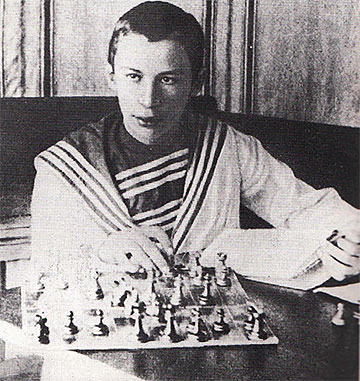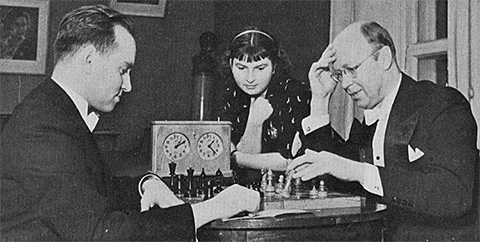


Winning starts with what you know
The new version 18 offers completely new possibilities for chess training and analysis: playing style analysis, search for strategic themes, access to 6 billion Lichess games, player preparation by matching Lichess games, download Chess.com games with built-in API, built-in cloud engine and much more.
The year was 1937 and the match had been officially announced. Ten classical games were to be played at the Master of Art Club in Moscow, played at a rate of three games per week, with Russian grandmaster Vladimir Alatortsev and the famed theoretician Ilya Kan overseeing it. The players were the renowned Sergey Prokofiev and David Oistrakh. Though a cup was announced as the prize, there was more at stake here.

The official announcement of the match between Sergei Prokofiev and David Oistrakh
Indeed the name Prokofiev needs little introduction, as one of the greatest composers of the twentieth century. However his connection to chess might be a little less obvious, even to the musically enlightened. As to David Oistrakh, he was one of the very greatest violinists, whose virtuosity ranked alongside Fritz Kreisler and Jascha Heifetz. Both of them were passionate chess players, though Prokofiev more than one would believe.

Prokofiev at the age of seven
Sergei Sergeyevich Prokofiev, born April 23, 1891, died March 5, 1953, was a Russian composer, pianist and conductor who mastered numerous musical genres and is regarded as one of the major composers of the 20th century, which include Igor Stravinsky, and Sergei Rachmaninoff. Among his best-known works are the 3rd Piano Concerto, the third and fifth symphonies, as well as composed family favourites, such as the ballet Romeo and Juliet – from which "Dance of the Knights" is taken – and Peter and the Wolf.
Boris Karloff narrates this 1940s-era recording of Prokofiev's "Peter and the Wolf,"
Op. 67. The Vienna State Opera Orchestra is conducted by Mario Rossi. While I
appreciate the Disney effort, it is far more enjoyable when you imagine it all in your
mind as you listen. Boris Karloff is unique as always.
The beautiful and infinitely talented Yuja Wang plays Prokofiev's 3rd Piano Concerto with the
Royal Concertgebouw Orchestra conducted by Daniele Gatti
No less significant were his famous collaborations with the great movie director Sergei Eisenstein, for whom he produced the full musical scores for the films Alexander Nevsky, and Ivan the Terrible.
This is the "Battle on the Ice" by Prokofiev for Sergei Eisenstein's epic film
"Alexander Nevsky". It shows the battle between Nevsky's troops and the knights
of the Teutonic Order on Lake Peipus. The full film is here.
Sergei Prokofiev fell in love with chess at an early age, and during his lifetime never lost his passion for the royal game, befriending chess greats such as Capablanca and Alekhine.

A young Sergey Prokofiev with his inseparable board and chess books
The composer met Alekhine in his native Russia in 1900 during an international tournament held there. Alekhine was a member of the organizing committee and Prokofiev had volunteered to accommodate the guests and the players. As the years passed, their friendship solidified. He met Capablanca in January 1914 in Petersburg where the Cuban champion was playing a series of simultaneous games. Prokofiev tried his luck and even managed to win a game!

Prokofiev submitted both to his famous Sun Autograph book. In it, he would ask the person signing to give their impressions of the sun. Jose Raul Capablanca, translated to English, wrote, “The sun is life. We are happy when we see it and feel blue when it disappears behind the clouds.”

A portrait of Prokofiev by Henri Matisse
On April 27, 1917, Prokofiev gave Alekhine his notebook and asked him to write something about the sun. After a moment’s deliberation, the future world champion scribbled down the following…“On gray, cloudy days, I dream about it, but when I see it, I start looking for dark spots on its surface… During eclipses I painfully enjoy waiting for it to come out…” The unusual statement says a great deal about Alekhine at the time.

Always seeking a chess partner, here he is playing Vasily Morolev, a veterinarian and friend
After the Revolution in 1917, Prokofiev left Russia with the official blessing of the Soviet minister Anatoly Lunacharsky, and he lived in the United States, then Germany, then Paris, during which time he married a Spanish singer, Carolina Codina, with whom he had two sons. Because of the increasing economic deprivation of Europe, Prokofiev returned to Russia in 1936.

Prokofiev in his later years remained faithful to his true love
Back home, Prokofiev found a good chess partner in the master violinist David Oistrakh. “Prokofiev was an avid player, he could spend hours on end thinking over his moves,” Oistrakh later recalled. “Living next door to each other, we often played blitz-contests and I wish you could see how excited he was drawing all kinds of colorful diagrams of his wins and losses, and how happy he was with each victory, as well as how devastated each time he lost…”
David Oistrakh (violin) plays the Tchaikovsky Violin Concerto No.1 with Gennady
Roshdestvensky conducting at the Staatskapelle Berlin in 1963.

David Oistrakh and Sergei Prokofiev in a game, with 18-year-old violinist Elizabeta
Gilels, daughter of piano great Emil Gilels, watching the game. Judging from Prokofiev's
attire, he was on his way to a concert... (thanks to R. Krishnan, Kuala Lumpur for
identifying the young lady)
Their rivalry over the board was such that in 1937 the Master of Art Club organized an official chess match between Sergei Prokofiev and David Oistrakh. Everything was for real, chess clocks, referees and, of course, the audience… The players were dead serious about the whole thing, staying awake nights, and feeling as nervous as if the world title were the object of the match. As a matter of fact, a wager was behind the affair, though nothing that might be reported in offical channels of course. Both great musicians were engaged for a concert tour, though only one was actually needed. Therefore it was decided that the loser of the match would be the one to do it (thanks to David Levy for this behind the scenes tidbit). The match was reported in the December 1937 issue of the notable Russian chess periodical '64', and one game survives to this day.

Of the ten games announced, only seven were actually played.Rumor had it that, sensing the imminent defeat, Oistrakh chose not to prolong the clear outcome, and went on the concert tour away from Moscow… The two musicians and rivals remained close friends until the end, and when Sergei Prokofiev died the same day Stalin’s death was announced, David Oistrakh and Mstislav Rostropovich, who were both engaged to play at the wake of the fallen autocrat, also played at their friend’s wake in his honor.